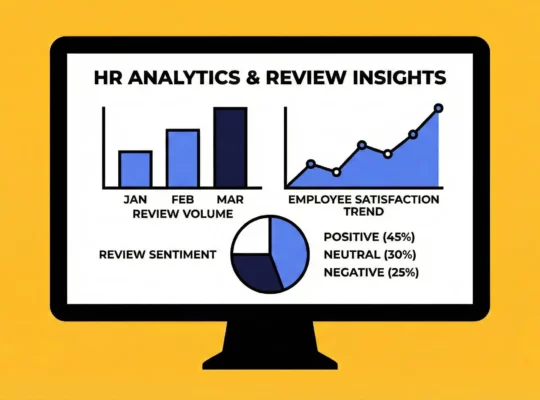Employee engagement challenges continue to disrupt workplaces globally. When employees aren’t engaged, businesses face high turnover, low productivity, and declining morale. Addressing these challenges head-on is crucial for maintaining a motivated, high-performing team. Review.jobs understands how critical engagement is to building a thriving workforce. Let’s dive into these challenges and explore solutions that can help improve employee engagement across organizations.
- What is Employee Engagement?
- Current State of Engagement
- Why Address Engagement Challenges?
- 10 Most Common Employee Engagement Challenges
- 1. Communication Gaps
- 2. Poor Leadership Engagement
- 3. Lack of Career Development Opportunities
- 4. Inefficient Use of People Analytics
- 5. Negative Workplace Culture
- 6. Insufficient Recognition and Rewards
- 7. Workload Imbalance and Burnout
- 8. Limited Employee Autonomy
- 9. Lack of Inclusivity and Diversity
- 10. Difficulty Measuring Employee Engagement
What is Employee Engagement?
Employee engagement refers to the emotional commitment an employee has toward their organization and its goals. Engaged employees are enthusiastic about their work and contribute positively to their teams, driving productivity and innovation.
In contrast, disengaged employees lack the motivation to give their best, negatively impacting the overall work environment.
Understanding and fostering engagement is key to creating a healthy, thriving workplace where both employees and the organization flourish.
Current State of Engagement
Engagement trends show that while companies are becoming more aware of its importance, many still struggle with addressing the root causes of disengagement. Studies have revealed that highly engaged employees are 21% more productive and 22% more profitable than their disengaged counterparts. Yet, despite these benefits, engagement levels remain stagnant, with Gallup reporting only about 33% of employees in the U.S. feeling engaged at work. Businesses must make engagement a top priority to ensure organizational success in an increasingly competitive landscape.
Why Address Engagement Challenges?
Disengaged employees are a ticking time bomb. They can wreak havoc on your organization’s productivity, morale, and bottom line. Here’s why:
- Absenteeism: Disengaged employees are more likely to call in sick or take unscheduled time off.
- Lower Productivity: They put in minimal effort and often produce subpar work.
- Increased Turnover: When employees feel disconnected, they’re more likely to seek opportunities elsewhere, leading to costly turnover.
The Bottom Line: Disengaged employees cost you money. Addressing these challenges is not just a nice-to-have; it’s a necessity for long-term success. By fostering employee engagement programs, you can boost productivity, improve job satisfaction, and drive organizational growth.
10 Most Common Employee Engagement Challenges
1. Communication Gaps
A common challenge in many organizations is the lack of open communication between employees and management or across teams. Without clear communication, misunderstandings arise, recognition is overlooked, and collaboration weakens.
The Ripple Effect of Disengagement: How it Impacts Your Organization
Disengaged employees can have a far-reaching impact on your organization, creating a ripple effect that affects both individuals and teams. Here’s how:
- Communication Breakdown: When employees feel unheard or undervalued, they may become less willing to share their thoughts and ideas, leading to communication breakdowns and a lack of collaboration.
- Silos Within the Organization: Disengagement can create silos within teams, as employees may withdraw from their colleagues and focus on their own tasks. This can hinder teamwork and reduce overall productivity.
- Reduced Innovation: Disengaged employees are less likely to take risks or think creatively, stifling innovation and hindering the organization’s ability to adapt to change.
- Negative Company Culture: Disengagement can contribute to a negative work environment, characterized by low morale, decreased job satisfaction, and increased turnover.
Bridging the Gap with Review.jobs
Organizations must implement open communication channels to encourage transparency and engagement. This could include regular team updates, feedback loops, and digital communication platforms, such as Review.jobs, that facilitate continuous dialogue between leaders and employees.
Review.jobs is a certified employee review management platform designed to help companies gather, analyze, and act on employee feedback in a structured way. It focuses on enhancing employee engagement, improving work culture, and addressing potential workplace issues before they impact productivity or turnover. The platform integrates with existing HR systems, making it easy for organizations to collect real-time feedback, run engagement surveys, and track employee sentiment.
Key Features:
- Customizable Feedback Mechanism: Allows organizations to tailor engagement surveys and feedback collection.
- Comprehensive Reporting: Offers in-depth insights and analytics that can inform strategic HR decisions.
- Integration with HR Tools: Easy integration with other HR systems, streamlining data management.
- Real-time Feedback: Helps companies take immediate action based on employee feedback.
2. Poor Leadership Engagement
Effective leadership is crucial for fostering a positive and engaged work environment. When leaders are disengaged or ineffective, it can have a cascading impact on employee morale, trust, and overall productivity.
The Domino Effect of Poor Leadership
- Decreased Morale: Disengaged leaders can create a negative and uninspiring work environment, leading to decreased morale and job satisfaction among employees.
- Increased Turnover: Employees who feel unsupported or undervalued by their leaders may be more likely to seek employment elsewhere, contributing to higher turnover rates.
- Lack of Cohesion: Poor leadership can erode trust and create divisions within teams, hindering collaboration and the organization’s ability to achieve its goals.
Solutions for Effective Leadership
- Leadership Training: Invest in leadership training programs to equip leaders with the necessary skills to inspire, motivate, and engage their teams.
- Open Communication: Encourage open and transparent communication between leaders and employees, fostering trust and understanding.
- Employee Feedback: Seek feedback from employees to identify areas for improvement and ensure that leaders are meeting their needs.
- Inclusive Leadership: Promote a culture of inclusion and diversity, ensuring that all employees feel valued and respected.
3. Lack of Career Development Opportunities
A stagnant career path can be a significant source of disengagement for employees. When individuals feel stuck in their roles, they may become frustrated, unmotivated, and more likely to seek opportunities elsewhere.
The Impact of Stagnation
- Increased Turnover: Employees who feel limited in their career growth are more likely to leave the organization in search of new challenges and opportunities.
- Decreased Engagement: A lack of career development can lead to decreased job satisfaction, reduced motivation, and lower engagement levels.
- Loss of Talent: When employees feel undervalued and limited in their growth potential, they may seek employment elsewhere, leading to a loss of valuable talent.
Solutions for Career Development
- Professional Development Programs: Offer a variety of training programs and workshops to help employees acquire new skills and knowledge.
- Mentorship Programs: Connect employees with experienced mentors who can provide guidance, support, and career advice.
- Clear Career Paths: Develop clear career paths and progression plans to help employees understand their opportunities for growth within the organization.
- Regular Performance Reviews: Conduct regular performance reviews to provide feedback, identify areas for development, and discuss career goals.
4. Inefficient Use of People Analytics
In today’s data-driven world, organizations have access to a wealth of information about their employees. However, many businesses fail to leverage this data effectively to address engagement issues. This missed opportunity can lead to suboptimal strategies and a continued lack of engagement.
The Impact of Ineffective Data Analysis
- Missed Insights: Without proper analysis, organizations may miss critical trends and patterns that could inform their engagement strategies.
- Ineffective Strategies: Lack of data-driven insights can lead to ineffective or misaligned engagement initiatives.
- Continued Disengagement: If engagement issues are not addressed, employee satisfaction and productivity may continue to decline.
Leveraging People Analytics
- Train Staff: Ensure that your HR team is trained to use these tools and interpret the data accurately.
- Identify Trends and Patterns: Analyze data to identify trends in employee satisfaction, engagement, and turnover.
- Tailor Engagement Strategies: Use insights from data analysis to create targeted engagement initiatives that address specific needs and concerns.
- Invest in HR Analytics Tools: Choose tools that can collect, analyze, and visualize employee data effectively.
3 Must-Have Employee Engagement Analysis Software
1. Lattice
Lattice is a comprehensive people management platform designed to help organizations streamline performance management, employee engagement, and development. It integrates tools for OKRs (Objectives and Key Results), 1:1 meetings, performance reviews, and employee feedback, making it a highly versatile solution for companies looking to enhance their people operations. Lattice’s platform is AI-powered and data-driven, helping organizations to track employee sentiment, improve manager productivity, and boost overall engagement and retention.
Pros:
- Comprehensive Performance Management: Combines performance reviews, goal tracking (OKRs), and 1:1s, making it easy for managers to stay aligned with team members.
- AI-Driven Insights: Provides actionable data through AI-powered analytics, helping organizations predict turnover and act on engagement trends.
- Engagement Surveys: Allows companies to gather real-time feedback and analyze sentiment to improve employee engagement.
- Customizable Integrations: Seamless integration with existing HR and tech stacks, providing a smoother workflow and data management process.
Cons:
- Complexity for Small Teams: Some features may be overwhelming for smaller businesses without a dedicated HR team.
- Cost: The advanced features, such as AI-powered analytics and compensation management, can be expensive for smaller organizations.
2. Leapsome
Leapsome is a people management and analytics platform that integrates performance, engagement, and learning tools. Its focus is on helping organizations understand their people better, boost engagement, and create a thriving work environment. Leapsome offers advanced people analytics, performance reviews, OKRs (Objectives and Key Results), and engagement surveys, making it an all-in-one solution for data-driven HR management.
Pros:
- Advanced Analytics: Provides actionable, data-driven recommendations and insights for building a strong workplace culture.
- Interlinked Modules: Integrates continuous feedback performance management, engagement surveys, and learning in one platform.
- Predictive Insights: Features such as turnover prediction help organizations proactively address employee engagement issues.
- Customizable Reporting: Allows for advanced segmentation and filtering of people data.
Cons:
- Complex Setup: Might require significant customization and setup time, especially for larger organizations.
- Pricing: The cost can be high for smaller companies or those without extensive HR resources.
3. 15Five
15Five is an employee engagement platform that provides a comprehensive HR outcomes dashboard, allowing companies to track employee engagement, performance, and retention. It is AI-powered, enabling HR teams to leverage real-time insights and create action plans for improving people outcomes. The platform also includes tools for performance management, feedback, and strategic action planning, making it a powerful tool for HR leaders looking to drive measurable business results.
Pros:
- HR Outcomes Dashboard: Offers strategic insights into engagement, performance, and retention metrics.
- AI-Driven Recommendations: Provides AI-powered action plans to drive measurable improvements.
- Comprehensive Performance Management: Links performance with business outcomes, ensuring HR strategies align with organizational goals.
- Effective for Manager Development: Tools for measuring and enhancing manager effectiveness.
Cons:
- Steep Learning Curve: May take time to master all features, particularly the analytics and dashboard tools.
- Cost: Advanced features may be costly for smaller organizations.
5. Negative Workplace Culture
A toxic workplace culture, characterized by stress, poor work-life balance, and unresolved conflicts, can have a detrimental impact on employee engagement, morale, and productivity.
The Consequences of Toxicity
- Increased Anxiety and Stress: A negative work environment can contribute to elevated stress levels and anxiety among employees.
- Decreased Morale: A toxic culture can erode employee morale, leading to feelings of dissatisfaction and disengagement.
- High Turnover Rates: Employees who are unhappy and stressed are more likely to seek employment elsewhere, contributing to increased turnover.
Creating a Positive Workplace Culture
To address a negative workplace culture, organizations should focus on:
- Transparency and Open Communication: Foster a culture of open communication and transparency to build trust and address issues proactively.
- Work-Life Balance: Promote a healthy work-life balance by offering flexible work arrangements, encouraging time off, and supporting mental health initiatives.
- Collaboration and Teamwork: Encourage collaboration and teamwork to create a supportive and positive work environment.
- Inclusive Culture: Promote diversity and inclusion to ensure that all employees feel valued and respected.
6. Insufficient Recognition and Rewards
A lack of recognition can be a significant demotivator for employees. When their achievements are not acknowledged or celebrated, they may feel undervalued and less engaged in their work.
The Impact of Unrecognized Efforts
- Decreased Productivity: Employees who feel unappreciated may be less motivated to put in effort and perform at their best.
- Lower Morale: A lack of recognition can erode employee morale and create a negative work environment.
- Increased Turnover: Employees who feel undervalued may be more likely to seek employment elsewhere, leading to higher turnover rates.
Solutions for Effective Recognition
- Structured Recognition Programs: Implement formal recognition programs that reward employees for their achievements and contributions.
- Peer-to-Peer Recognition: Encourage employees to recognize and appreciate the work of their colleagues.
- Public Acknowledgement: Celebrate successes publicly, such as in team meetings or company-wide communications.
- Personalized Rewards: Tailor rewards to individual preferences and interests to make them more meaningful.
- Regular Feedback: Provide regular feedback and recognition to reinforce positive behaviors and address areas for improvement.
7. Workload Imbalance and Burnout
An excessive workload can lead to burnout, a state of physical, emotional, and mental exhaustion that can have a detrimental impact on employee engagement and productivity.
The Consequences of Burnout
- Disengagement: Burnout can lead to decreased motivation, reduced job satisfaction, and a sense of detachment from work.
- Absenteeism and Turnover: Employees who are experiencing burnout may be more likely to take time off or leave the organization altogether.
- Reduced Productivity: Burnout can impair an employee’s ability to concentrate, make decisions, and perform effectively.
Preventing Burnout and Promoting Engagement
To address workload imbalance and prevent burnout, organizations should:
- Ensure Fair Workload Distribution: Distribute work equitably among team members to prevent overload and underutilization.
- Flexible Work Arrangements: Offer flexible work arrangements, such as flexible hours, remote work options, or compressed workweeks, to help employees manage their workload and maintain a healthy work-life balance.
- Mental Health Initiatives: Prioritize mental health and well-being by providing access to counseling services, stress management workshops, and other support resources.
- Encourage Breaks and Vacations: Encourage employees to take regular breaks and vacations to rest and recharge.
- Set Realistic Expectations: Avoid setting unrealistic deadlines or expectations that can contribute to stress and burnout.
8. Limited Employee Autonomy
Micromanagement and excessive control over tasks can have a detrimental impact on employee engagement and motivation. When employees feel constrained and limited in their autonomy, they may become disengaged, less productive, and less likely to take ownership of their work.
The Consequences of Micromanagement
- Stifled Creativity: Micromanagement can limit employees’ ability to think creatively and come up with innovative solutions.
- Decreased Motivation: Employees who feel micromanaged may become demotivated and lose their sense of purpose.
- Reduced Engagement: A lack of autonomy can lead to disengagement and a feeling of disconnection from the organization.
Fostering Autonomy and Empowerment
To promote employee engagement and productivity, organizations should:
- Trust and Delegate: Trust employees to take ownership of their work and make decisions within their scope of responsibility.
- Provide Clear Expectations: Set clear goals and expectations, while allowing employees flexibility in how they achieve them.
- Encourage Feedback: Create a culture of open communication and feedback, where employees feel comfortable sharing their ideas and suggestions.
- Recognize and Reward Initiative: Acknowledge and reward employees for taking initiative and demonstrating creativity.
9. Lack of Inclusivity and Diversity
A diverse and inclusive workplace is essential for fostering employee engagement and creating a positive work environment. When employees feel excluded or marginalized, it can have a detrimental impact on their motivation, job satisfaction, and overall well-being.
The Consequences of Exclusion
- Decreased Engagement: Employees who feel excluded or marginalized may become disengaged and less motivated to contribute to their work.
- Reduced Innovation: A lack of diversity can stifle creativity and innovation, as different perspectives and experiences are essential for problem-solving and generating new ideas.
- Negative Company Culture: Exclusion can contribute to a negative and unwelcoming work environment, leading to low morale and increased turnover.
Promoting Inclusivity and Diversity
To create a more inclusive and engaging workplace, organizations should:
- Establish Inclusive Hiring Practices: Develop hiring practices that seek out and attract talent from diverse backgrounds.
- Foster a Culture of Inclusion: Create a workplace culture that values diversity and promotes inclusivity, where everyone feels respected and valued.
- Develop Diverse Leadership: Ensure that leadership teams reflect the diversity of the workforce to provide role models and mentors for underrepresented employees.
- Provide Diversity and Inclusion Training: Offer training programs to help employees understand the importance of diversity and inclusion, and how to create a more inclusive workplace.
- Listen to Employee Feedback: Regularly seek feedback from employees to identify areas where improvements can be made to promote inclusivity.
10. Difficulty Measuring Employee Engagement
Measuring employee engagement is a critical step in understanding and addressing the needs of your workforce. However, many organizations struggle to effectively track and assess engagement levels, leading to ineffective strategies and a lack of progress.
The Impact of Ineffective Measurement
- Misdirected Efforts: Without clear metrics, organizations may waste resources on strategies that do not address the root causes of disengagement.
- Missed Opportunities: A lack of data can prevent organizations from identifying trends, patterns, and areas for improvement.
- Continued Disengagement: If engagement issues are not addressed, employee satisfaction and productivity may continue to decline.
Effective Engagement Measurement
To accurately measure employee engagement, organizations should:
- Conduct Regular Surveys: Use employee engagement surveys to gather feedback on various aspects of the employee experience, such as job satisfaction, work-life balance, and communication.
- One-on-One Interviews: Conduct regular one-on-one meetings with employees to discuss their engagement levels, identify challenges, and gather feedback.
- Track Key Performance Indicators (KPIs): Monitor KPIs related to engagement, such as absenteeism, turnover, and employee productivity.
- Analyze Data: Use data analytics tools to analyze employee feedback and identify trends and patterns.
Addressing employee engagement challenges is critical to creating a motivated and productive workforce. From communication gaps and leadership disengagement to issues with career development and measuring engagement, overcoming these obstacles can lead to significant improvements in productivity, retention, and overall company culture. At Review.jobs, we offer tools and services that help businesses measure, track, and improve employee engagement, ensuring that their workforce remains motivated, engaged, and thriving. Prioritize employee engagement today to create a positive, thriving workplace.





